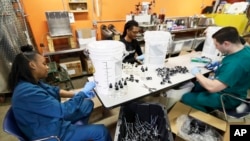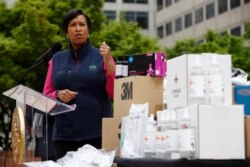Americans are facing an unprecedented shortage of paper and cleaning products, especially disinfectants, hand sanitizers and wipes. Asked when they would be available, retailers typically tell shoppers the day of delivery but that they don’t know when that will be.
Washing hands with soap and using household cleaners may help with personal protection against the coronavirus, but disinfectant liquid and wipes are handy for use outdoors, in public spaces and in vehicles. They are especially needed by people in essential jobs that cannot be performed from home. So, the demand for sanitizers remains high despite restrictions on outdoor movement. But there is little hope that they will soon return to the stores in sufficient quantities to meet the demand.
VOA has reached out to one of the top sellers of health and personal care products in the U.S. to explain the persistent shortage of hand sanitizers since the COVID-19 became a health crisis in the United States earlier this month.
“The current explosion in demand for hand sanitizers was never expected by anyone in the industry, and for that reason, none of the players in the market were prepared for this demand,” said Rakesh Tammabattula, CEO of California based company QYK Brands, which owns brands such as Dr J's Natural and Glowy.com Hand Sanitizer.
“Hand sanitizers were always an accessory product to hand wash soaps and liquids, and there was never any emphasis on the importance of using them for personal hygiene and disinfection as much as it was seen over the last month and a half,” he said.
Tammabattula told VOA that the unexpectedly high demand has caused severe shortages of raw materials such as alcohol and plastic bottles or pumps. Most sanitizers are made of isopropyl or ethyl alcohol, mixed with gelling substances and moisturizing oils. Manufactures rarely store large amounts of alcohol because of its hazardous and perishable nature.
The skyrocketing demands have caused the prices of the ingredients to go up about 200%, Tammabattula said, and the timelines of production have extended from a normal 2-3 weeks to 6-8 weeks or more. His firm is two weeks away from running out of alcohol for hand sanitizers.
The shortage of typical ingredients for sanitizers has prompted searches for alternatives. The U.S. Food and Drug Administration has recently relaxed the rules to permit the use of ethanol alcohol for hand sanitizers during the shortage. The COVID-19 crisis has sent the prices of ethanol plummeting, hurting U.S. corn farmers and ethanol industries that produce alcohol from corn. A cut in production has affected health care, which is running out of pharmaceutical grade sanitizers. The new FDA rule could help all of the affected sectors.
Some whiskey distilleries have turned to producing sanitizers from their own alcohol to help fill the gap. A distillery in Atlanta, Georgia, said it is providing free hand sanitizers at its facility.
As a last resort, many online outlets offer recipes for homemade sanitizers, typically with rubbing alcohol, aloe vera gel and maybe some type of essential oil or lemon juice.
Since rubbing alcohol is becoming as hard to find as sanitizer, substitutes are taking its place.
Experts advise against improvised sanitizers, saying the mixtures could be harmful, or useless. An efficient sanitizer should contain at least 60% alcohol, which is hard for both distilleries and households to obtain.
The shortage of cleaning and disinfecting products has prompted many sellers to push UV-wands, wipes, sanitizers, air purifiers and similar items claiming they kill the virus, on Facebook, Amazon and other online outlets. Cyber security firms have advised users to be cautious because most of these products are useless, they may never arrive, and the seller may disappear without a trace.
The U.S. Centers for Disease Control and Prevention says washing hands with soap and water remains the most efficient way to remove all type of germs and toxins and should be practiced as often as possible.







